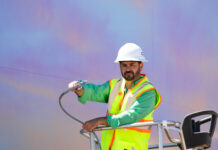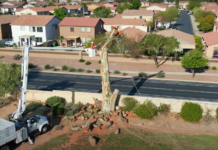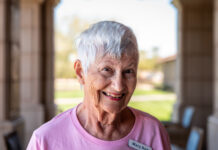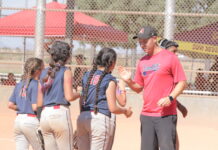It’s not just mad dogs and Englishmen. A variety of vocations require workers to be out in the midday sun. With triple-digit heat at hand in Maricopa, health experts, employers and workers have been preparing for the onslaught for weeks.
The Arizona Division of Occupational Safety and Health (ADOSH) provides seminars and webinars training employees on the signs of heat distress. For most situations, measures can be taken to reduce the risks.
“Water, rest and shade” is the ADOSH mantra to employers.
Mike Riggs, parks manager for the City of Maricopa, said his crews are now starting an hour earlier at 5 a.m. With days consisting of mowing, weeding, tree trimming, irrigation, ball field preparation and other park maintenance, they have a lot of exposure to the sun.
“We provide ice, all the guys have water jugs, we have electrolytes,” Riggs said. “We pretty much let them regulate themselves, depending on what they’re doing.”
Street maintenance crews get started even earlier, according to Public Works Director Bill Fay. And his department has water in its health and safety budget. Most of the street department equipment is air conditioned, though some have open cabs. The department supplies workers with hard hats with shade extenders.
Jessie Atencio, ADOSH assistant director, offered tips for employers and employees to prevent heat exhaustion and heat stroke. Workers frequently deal with the sun and the heat radiating off heavy equipment, he said. His advice also applies to those involved in leisure activities in the sun.
1. Preplan the day.
When temperatures rise, “you have a lot of employees out there doing heavy, strenuous work,” Atencio said. “It’s important for employers to know what planning and what projects [they] need to do during the most intense portion of the day when the heat is the worst, and shift work.”
Construction workers commonly work at night or in the early morning to avoid the danger zone of 2-6 p.m. Part of preplanning when work is in remote areas is to have emergency training if a worker suffers a heat-related illness and it will take several minutes for paramedics to arrive.
2. Get training on signs of symptoms.
According to Atencio, symptoms of heat exhaustion, which many dismiss as a simple headache or as just being tired or hungry, include headaches, dizziness, weakness, moist skin, mood changes and an upset stomach. The more serious heat stroke causes dry, hot skin with no sweating, mental confusion and seizures or convulsions. Ultimately, either condition can lead to death, he said. That makes training in recognizing the signs personally and in co-workers vital.
Atencio said best-practices companies provide outreach and reminders, making a game of it with flash cards. ADOSH seeks to create open dialogue between employer and employees regarding the conditions and whether there is adequate water available.
3. Wear appropriate clothing and sunscreen.
Choose lightweight, light-colored, loose-fitting clothing. In the hot sun, a hat and sunscreen is helpful, Atencio said. Wear light, loose-wicking clothing so sweat can evaporate. Wear a hat that provides shade and ventilation. Sunblock should be at least SPF 15.
Umbrellas on the job site are also becoming commonplace. “That’s excellent,” Atencio said. “The last time I looked there weren’t a lot of trees along the major interstates in Arizona. If you pay close enough attention, you’ll see these work trucks with tools set up in the bed, and they’ll have an umbrella or shade.”
4. Make healthy food and drink choices.
“We’re in an age of caffeinated drinks, and I don’t see that stopping,” Atencio said. “When they’re drinking caffeinated drinks the day before they’re going to have strenuous work, the employee is more susceptible and more vulnerable to heat stress.”
He said electrolyte drinks like Gatorade and the new Squincher packets are good, “but there is never, ever an excuse for not having water. Water should never be substituted.”
He said anyone engaged in activities in high temperatures should drink eight ounces of water every 15 minutes. Avoid hot foods, alcohol and heavy foods that increase your core temperature.
5. Take rest breaks in the shade.
Equally important as staying hydrated is ensuring you are taking adequate breaks in a shaded area. Employees should always take breaks of at least five minutes. Depending on how hot it is, the breaks can take place every 30 to 60 minutes.
For Maricopa parks crews, most of the equipment has shades. The department provides sunscreen and summer hats and recommends crew members wear long-sleeve shirts.
“The big thing for us is making sure they stay hydrated,” Riggs said.
Atencio, ADOSH’s training program manager, said ADOSH offers free training on dealing with heat, with no threat of reprisals or fines. They can call the toll-free number 855-268-5251.
ADOSH has a quarterly newsletter called the ADOSH Advocate, part of an effort to reach vulnerable populations with information on job safety. It also contains a list of free training sessions. There are also posters and brochures to remind workers of tips they have already received.
Employees schooling themselves and employers looking after their employees’ needs are vital to making it through the hot summer days.
“We can’t afford not to,” Riggs said.
Upcoming ADOSH heat safety trainings
Three-hour classes on Heat Stress and Haboob Safety will be offered throughout the summer and early fall to remind employers and employees of the hazards of working in hot environments, the need to hydrate and how lifestyle choices can put them at risk for heat-related illness, even heat stroke. Signs and symptoms of heat stress are discussed and the requirements for employers to provide protection through engineering, work practice or personal protective equipment controls. The Haboob Safety portion will address the hazards associated with working and driving during a dust storm and the need to train employees regarding the hazard of contracting Valley Fever, a fungus caused respiratory and systemic illness.


















